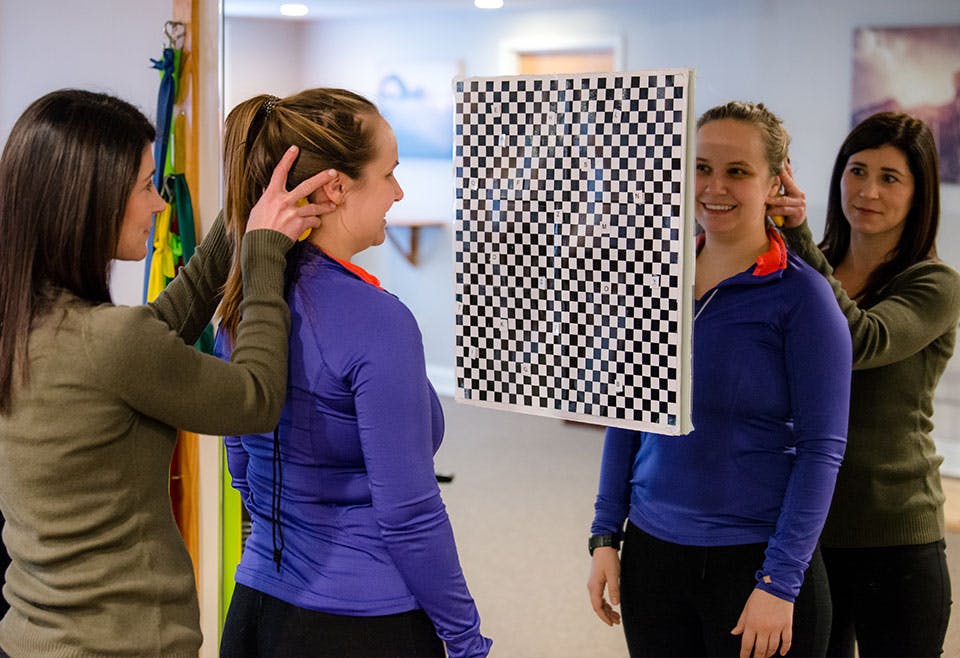
When most people think Physical Therapy, orthopedic and sports injuries tend to be some of the first ideas to come to mind. These issues are common, but physical therapists can treat numerous conditions. Below is a list of surprising treatable conditions you may not have known a physical therapist could treat.
Top 7 Conditions Physical Therapists Treat
- Jaw Pain: Jaw pain or TMJ is pain coming from the temporal-mandibular joint. This pain can manifest itself as clicking and/or locking of the jaw, headaches, and ear pain. TMJ pain can limit someone’s ability to eat, talk, sleep, and even yawn. Physical Therapy is one way to help reduce and manage TMJ related symptoms. This is done through hands-on therapy techniques, including joint stretching, soft tissue mobilization, and using instruments to increase the flexibility of the muscles. Additionally, physical therapy provides tools needed to manage symptoms independently such as exercise and education on diet and sleep modifications.
- Headaches: According to the World Health Organization approximately 1/2 – 3/4 of adults aged 18-65 had at least 1 headache in the past year. 30% of people are reporting a migraine type of headache. In addition to head pain, headaches and migraines are commonly accompanied by neck pain. Physical therapy is one alternative to treating chronic head and neck pain symptoms. Through various hands-on and educational techniques including soft tissue mobilization, joint and muscle stretching of the neck, and postural exercise, physical therapy helps people reduce the frequency and intensity of their headache symptoms quickly without medications.
- Dizziness and Vertigo: Have you ever experienced room-spinning dizziness when you turn over in bed or bend forward? Dizziness and vertigo are resolved with physical therapy. The feeling of vertigo with various head movements, especially with turning in bed, is often the result of displaced crystals in your inner ear canal. The sensation is known as BPPV (benign paroxysmal positional vertigo). Tiny crystals get stuck in the canals of your ear causing symptoms including vertigo, nausea, lightheadedness, or even loss of balance. Treatment consists of a series of head movements to move the crystals out of the canal into their usual position to stop the feeling of vertigo.
- Concussion: When someone is diagnosed with a concussion, sometimes there aren’t any visible signs of distress. Concussions leave a major impact on someone’s quality of life. They affect their ability to participate in work, school, or even recreational activities. Common symptoms of concussion include light and sound sensitivity, nausea, headaches, blurred or double vision, difficulty concentrating/focusing, mental confusion, disturbed sleep, irritability/mood changes, and loss of balance. Typical recovery for a concussion may only be a few days or weeks, sometimes symptoms may last longer than normal. Treatment for a concussion consists of a multidisciplinary team that includes Physical Therapy. Symptoms from a concussion are treatable through therapy. This consists of eye exercises, balance training, cognitive tasks, and cardiovascular exercise, depending on a patient’s individual needs.
- Pelvic Floor Dysfunction: Pelvic pain and incontinence are personal and intimate topics that severely impact one’s health and well being. Physical therapy is an effective way to help manage and improve pelvic health symptoms. Treatment consists of internal and strategies improving pelvic floor and core stability, physical therapy helps reduce and manage symptoms. Common treatable pelvic floor conditions include loss of urine, an urgency to urinate, pain with intercourse, prolapse, and post-partum recovery.
- Parkinson’s Disease: Parkinson’s disease is the second most common age-related neurodegenerative disorder. There are an estimated 7 to 10 million people with Parkinson’s disease worldwide. Parkinson’s disease (PD) primarily affects dopamine-producing neurons in the area of the brain called the substantia nigra which plays a major role in the movement. Symptoms and the progression of PD vary from person to person. They typically include but are not limited to: tremors, bradykinesia (slowness of movement), hypokinesia (reduced amplitude of movement), limb rigidity, and gait and balance problems. The cause of PD is largely unknown, and there is currently no known cure for PD. However, many times, people with PD can manage and slow the progression of PD through the use of medication, surgery via deep brain stimulator, and exercises including physical therapy. Physical therapy for neurological conditions is a great tool to manage and improve symptoms of PD. Through exercises with a focus on the increasing amplitude and a drive for high-effort practice, people with PD have shown to improve their walking speed and safety with bigger steps, balance, and increased trunk rotation to allow them to be more functional and independent at home.
- Multiple Sclerosis: Multiple Sclerosis (MS) is a chronic disease of the central nervous system that disrupts the communication between the brain and the body. MS works by damaging the nerve coverings that transport information throughout the body. Imaging tests and lab tests can diagnose MS. It results in symptoms including vision loss, pain, fatigue, weakness, and impaired coordination. Just like in PD, symptoms can vary from person to person with an unknown cause and no known cure. Women are 2-3x more affected than men with the majority of diagnoses occurring between the ages of 20 and 50. Treatment for MS includes medication management, exercise, and physical therapy. There is currently no intervention proven to effectively modify long-term disease prognosis (with the exception of stem cell transplant). Exercise therapy is one of the most important parts of the symptomatic and supportive treatment for people with MS. Physical therapy for MS aims to increase daily function and independence with MS, including transfers, bed mobility, walking, and balancing.
Conclusion
If you have questions, remember to talk to your physician or trusted physical therapist for further information and treatment. Physical therapy is a great resource in managing multiple conditions throughout the body. For more information on how Action Potential can help you, request an appointment today.
Photo by Robina Weermeijer on Unsplash
